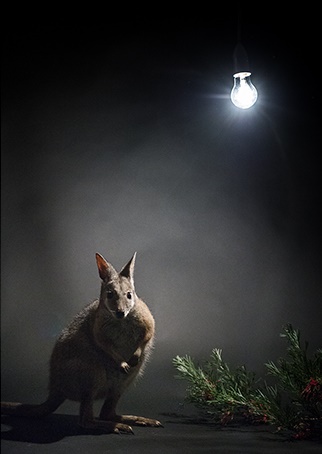Why artificial light is a growing conservation concern with effects on reproductive cycles of wildlife.

New research published in Proceedings B this week suggests that artificial lighting disrupts the reproductive cycle of wild wallabies on Garden Island, Australia. Lead author Dr Kylie Robert describes this phenomenon, and explains why artificial light is a growing global conservation concern.
What effect does light have on reproduction?
The 24-hour cycle of day and night has been use to regulate activities for millions of years. This circadian rhythm of bright days and dark nights are important for seasonally breeding species that use day length to determine time of year. By breeding during particular seasons these species can time the production of their offspring so that environmental conditions are optimal for survival of their young.

Credit: Kylie Robert
How does artificial light affect this process?
Light has physiological effects, most notably on the secretion of melatonin. Melatonin is a hormone that is secreted in high levels during periods of darkness and is suppressed by light. Artificial light extends the period of daylight and suppresses melatonin secretion so that the physiological signal for day length and time of year is masked in urban environments.
How did your study measure these effects in a wild mammal?
The annual cycle of reproduction is highly synchronous in the tammar wallaby and cued by change in day length and the hormone melatonin. Using a multi-year study on two populations of wild free-ranging wallabies exposed to different levels of human made disturbance we measured their levels of nighttime light exposure, circulating nighttime melatonin levels and the timing of breeding.
What did you find?
We found that wallabies in natural environments were exposed only to astronomical sources of light, including a clear lunar cycle. Conversely, such natural cues were not apparent in light polluted environments owing to an order of magnitude increase in nighttime light intensity. Wallabies from light polluted environments had significantly suppressed nighttime melatonin levels and a month long delay in the birth of their offspring. The resulting delay in the birth of their young results in a mismatch with optimal food resources to raise their young.
Why is this important to global conservation?
Light pollution is increasing at a faster rate than any other human made disturbance. More alarmingly, with a desire to reduce CO2 emissions globally and meet climate change targets there is an increasing growth rate in the use of energy-efficient light sources such as high brightness white light-emitting diodes (LEDs). Despite the energetic benefits of LEDs, the large scale adoption of LEDs for outdoor lighting is of growing concern as they emit wavelengths in the blue spectra which suppress melatonin at a rate 5 times that of traditionally used outdoor lighting.

Credit: Michelle McFarlane
You can read the full article via the Proceedings B website. To receive article alerts of our latest content please sign up online here.
